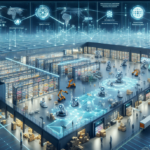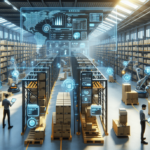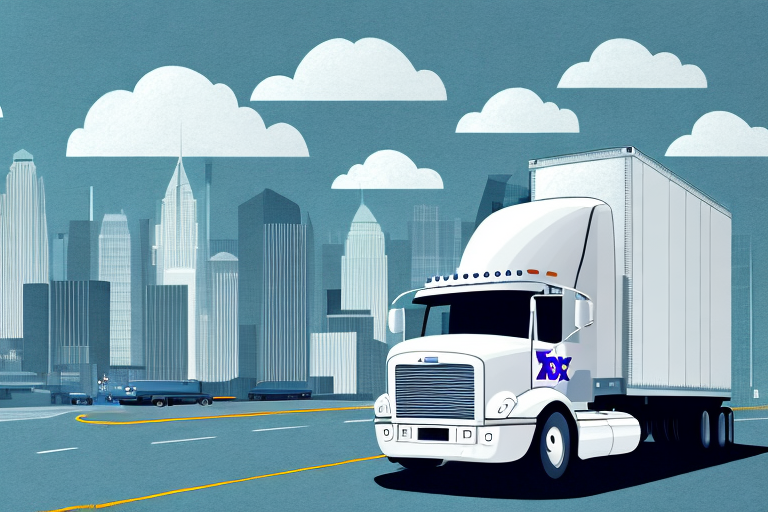Exploring the Latest Developments in New Logistics
Logistics is an ever-evolving industry that is continually seeking to improve efficiency, reduce costs, and meet the growing demands of businesses and customers. In recent years, technology has played a crucial role in shaping the logistics landscape. This article explores the latest developments in new logistics, highlighting how technology is revolutionizing the logistics industry, predicting trends to watch out for, and discussing solutions to challenges in the sector.
How Technology is Revolutionizing the Logistics Industry
Technology is significantly impacting the logistics industry by providing new ways to manage, track, and deliver goods. The integration of GPS and RFID technologies in transportation and warehousing operations allows logistics managers to track shipments in real-time accurately. According to a IBM report, RFID can improve inventory accuracy by up to 99%, enabling companies to identify inefficiencies, reduce delivery times, and enhance customer satisfaction.
Automation and Artificial Intelligence
The use of robots, automation, and artificial intelligence (AI) is transforming the logistics sector. Automated machines can transport, store, and manage materials more efficiently, reducing errors and speeding up order processing time. AI-powered algorithms help logistics managers optimize routes and predict delivery times more accurately, while chatbots enhance customer service interactions.
Blockchain Technology
Blockchain technology provides a secure and transparent method for tracking goods and transactions throughout the supply chain. This technology helps reduce fraud, increase transparency, and improve traceability, which is crucial in industries such as food and pharmaceuticals. According to a Forbes article, blockchain can decrease fraud in supply chains by up to 50%.
Internet of Things (IoT)
The Internet of Things (IoT) plays a significant role in the logistics industry. IoT devices like sensors and beacons provide real-time data on the location, condition, and temperature of goods in transit. This information helps logistics managers make informed decisions, optimize routes, and ensure that goods are delivered in optimal condition. A report by Analytics Insight highlights that IoT can reduce operational costs by 30% through improved efficiency.
The Future of Logistics: Predictions and Trends to Watch Out for
Despite challenges and disruptions caused by the COVID-19 pandemic, the logistics industry is poised for growth in the coming years. E-commerce, for example, is expected to continue its dominant position, driving logistics providers to offer more flexible and efficient delivery options.
Growth of E-commerce
The e-commerce sector continues to expand, with global e-commerce sales projected to reach $6.3 trillion by 2024, according to Statista. This growth necessitates more sophisticated logistics solutions to handle increased volume and diverse delivery requirements.
Big Data Analytics
The use of Big Data analytics is set to gain more momentum, helping logistics businesses optimize their supply chains, track goods, and improve customer service. Innovative solutions incorporating traceability, blockchain transparency, and enhanced security are expected to emerge, as highlighted in a Harvard Business Review article.
Adoption of Automation and Robotics
Automation and robotics will see increased adoption in the logistics sector. With the rise of e-commerce, logistics companies are turning to drones for last-mile delivery, autonomous vehicles for transportation, and robots for warehouse management and order fulfillment. According to a McKinsey report, automation can reduce logistics costs by up to 20% while improving delivery speeds.
The Impact of E-commerce on the Logistics Sector
E-commerce has revolutionized the way we shop and is transforming the logistics sector, driving significant growth and efficiency gains. As the e-commerce world evolves, delivery services and options are becoming more sophisticated. It's no longer just about getting goods on time, but also about delivering them efficiently.
Last-Mile Delivery Challenges
One of the biggest challenges logistics companies face in the e-commerce era is last-mile delivery—the final leg from the distribution center to the customer's doorstep. Last-mile delivery is often the most expensive and time-consuming part of the process. To overcome this challenge, companies are exploring technologies such as drones and autonomous vehicles to make last-mile delivery more efficient and cost-effective.
Reverse Logistics
E-commerce has also led to a rise in reverse logistics, which involves handling returns and exchanges. With the increase in online shopping, the volume of returns has surged. Logistics companies must develop efficient and cost-effective reverse logistics processes to manage the transportation of returned goods, process returns, and manage inventory levels effectively.
New Innovations in Last-Mile Delivery Services
Providing reliable, fast, and cost-effective last-mile delivery services remains a significant challenge for logistics companies. Innovations such as parcel lockers, drone delivery, and autonomous vehicles are transforming this segment.
Drone and Autonomous Vehicle Technology
Using drones and autonomous vehicles can improve delivery speed and accuracy while reducing costs. A Forbes article notes that drone deliveries can cut delivery times by up to 70%, especially in urban areas with heavy traffic.
Delivery Robots
Robots designed to navigate sidewalks and roads are becoming more prevalent in last-mile delivery. Equipped with sensors and cameras, these robots can safely deliver packages directly to customers' doorsteps, reducing delivery times and costs while enhancing the customer experience.
The Role of Big Data Analytics in Modern-Day Logistics
Big Data analytics is becoming a critical component of modern-day logistics, enabling providers to identify patterns, optimize routes, predict demand, and manage inventory more efficiently. Through sophisticated data analyses, logistics operators can determine the exact location and contents of their containers and track inventory levels accurately.
Supply Chain Optimization
Big Data analytics helps logistics providers improve supply chain management by identifying potential bottlenecks and areas for improvement. By analyzing data from various sources such as weather forecasts, traffic reports, and customer demand patterns, companies can make informed decisions about the most efficient routes, optimal delivery times, and inventory levels. This leads to reduced costs and improved customer satisfaction.
Predictive Analytics
Predictive analytics allows logistics companies to forecast demand trends and adjust their operations accordingly. According to a Gartner report, the global Big Data market is expected to grow to $274.3 billion by 2022, highlighting the increasing reliance on data-driven decision-making in logistics.
How Automation is Streamlining Warehouse Operations
Automation is rapidly transforming warehouse and distribution center environments, streamlining processes, and enhancing efficiency. Technologies such as robotic picking, conveyor systems, and automated storage solutions optimize warehouse operations, reducing errors and increasing order accuracy.
Robotic Picking and Automated Storage
Robotic picking systems can handle larger volumes of orders with greater speed and accuracy, crucial for the e-commerce industry where fast and reliable delivery is expected. Automated storage solutions like vertical lift modules and carousels optimize space utilization, allowing warehouses to store more inventory without expanding their physical footprint.
Enhanced Productivity and Cost Savings
Automation not only improves the speed and accuracy of warehouse operations but also reduces operational costs. According to a Warehouse Today article, automation can boost warehouse productivity by up to 35% while decreasing labor costs by 25%.
The Importance of Supply Chain Visibility in Logistics Management
Supply chain visibility is critical for logistics companies, enabling them to track goods effectively and ensure they are in the right place at the right time. Real-time tracking allows logistics providers to monitor shipment progress, adjust delivery schedules to meet customer demand, and reduce the chance of delivery failures.
Building Customer Trust
By providing customers with accurate tracking information and transparent reports of supply chain operations, logistics companies can build trust and enhance customer retention. Transparency in the supply chain also allows customers to have greater confidence in the delivery process.
Proactive Disruption Management
Supply chain visibility allows logistics companies to identify potential disruptions and mitigate them before they occur. Real-time data enables quick identification of delays or issues, allowing companies to take corrective action to prevent further disruptions and maintain customer satisfaction.
Operational Optimization
Analyzing data on shipping routes, delivery times, and inventory levels helps logistics providers optimize their operations and reduce costs. This leads to improved transportation efficiency, better inventory management, and increased profitability.
Sustainable Logistics: Ways to Reduce Carbon Footprint in Transportation
Logistics companies are increasingly focused on reducing their carbon footprint by adopting sustainable transport solutions that are less polluting and more efficient. Sustainable logistics solutions include using renewable energy sources, hydrogen fuel cells, and electric vehicles.
Renewable Energy and Electric Vehicles
Adopting renewable energy sources such as solar and wind power, along with electric vehicles, significantly reduces greenhouse gas emissions. According to a International Energy Agency report, transitioning to electric vehicles in logistics could reduce emissions by up to 70% by 2040.
Route Optimization
Optimizing delivery routes to reduce empty miles is an effective way to lower carbon emissions. Advanced analytics and route optimization software help logistics companies plan the most efficient routes, reducing fuel consumption and emissions while improving delivery times and lowering costs.
Challenges Faced by the Logistics Industry and Solutions to Overcome Them
The logistics industry faces significant challenges, including rising fuel costs, outdated infrastructure, driver shortages, and increasing customer demands. Addressing these challenges requires investment in innovative technologies, effective logistics management solutions, and strategic partnerships.
Rising Fuel Costs and Infrastructure Issues
Rising fuel costs can significantly impact logistics operations. Investing in fuel-efficient technologies and alternative energy sources can help mitigate these costs. Additionally, upgrading infrastructure to support modern logistics operations is essential for maintaining efficiency and competitiveness.
Driver Shortages
The logistics industry is experiencing a shortage of qualified drivers. Solutions include investing in driver training programs, offering competitive wages and benefits, and exploring autonomous vehicle technologies to supplement the workforce.
Meeting Increasing Customer Demands
Customers today expect faster and more reliable deliveries. Logistics providers must adopt flexible and scalable solutions to meet these demands, such as expanding delivery networks, utilizing advanced tracking systems, and enhancing customer service capabilities.
Integrating Artificial Intelligence in Logistics Operations for Enhanced Efficiency
The integration of artificial intelligence (AI) in logistics operations is transforming the sector by providing fast and efficient solutions for transportation, warehousing, and delivery needs. AI-powered solutions include predictive maintenance programs, smart route planning algorithms, and automated order processing systems.
Predictive Maintenance
AI-driven predictive maintenance helps logistics companies anticipate equipment failures before they occur, reducing downtime and maintenance costs. According to a McKinsey report, predictive maintenance can decrease maintenance costs by up to 30%.
Smart Route Planning
AI algorithms analyze vast amounts of data to determine the most efficient routes for deliveries. This results in optimized fuel usage, reduced delivery times, and enhanced overall efficiency.
Automated Order Processing
AI automates order processing, reducing human error and increasing processing speed. This leads to higher order accuracy and customer satisfaction.
Exploring New Business Models for Logistic Service Providers
Logistics companies are increasingly looking for innovative business models to differentiate themselves from competitors. Adopting platform-based models and focusing on specific verticals such as cold chain logistics, inventory management, or fulfillment services are some strategies being employed.
Platform-Based Models
Platform-based models facilitate better connectivity between shippers and carriers, improving efficiency and reducing costs. These platforms leverage technology to create more transparent and flexible logistics solutions.
Specialized Services
Focusing on specialized services like cold chain logistics for perishable goods or inventory management for high-value items allows logistics providers to cater to niche markets, enhancing their value proposition and market position.
Agility and Diversification
Exploring new business models allows logistics providers to be more agile and diversified, enabling them to adapt to a rapidly changing environment and meet diverse customer needs.
Conclusion
The logistics industry is a dynamic and rapidly changing sector. As technology continues to evolve, logistics providers must remain agile and embrace new solutions, enhancing their capabilities and finding innovative ways to deliver high-quality services to customers. By adopting the latest trends and solutions, the logistics industry will continue to innovate and grow, playing a vital role in the global economy.




















